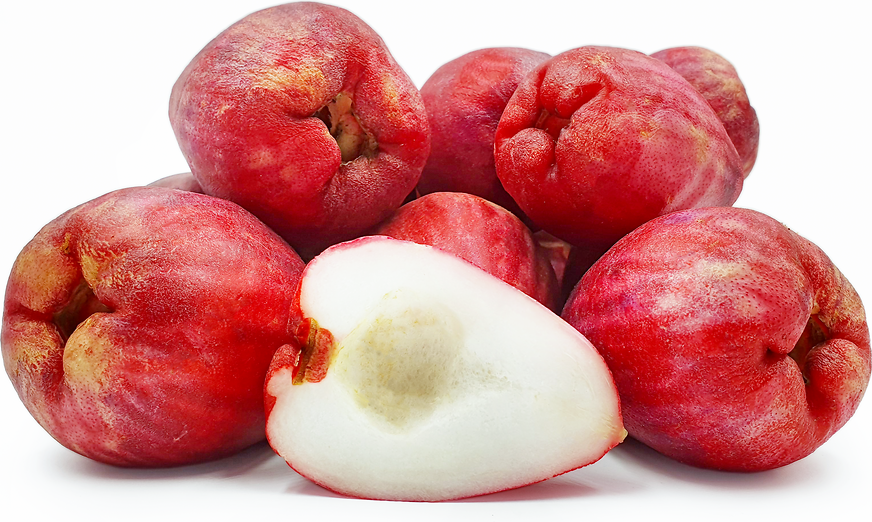


Bol Jamaica Jambu
Estimated Inventory, lb : 0
Description/Taste
Bol Jamaica jambu is one of the largest jambu varieties, averaging 5 to 8 centimeters in diameter, and has a bulbous, oblong to bell-like shape. The skin is smooth, waxy, glossy, and thin, appearing pink to bright red when unripe, transitioning into a dark red, burgundy hue with maturity. There may also be faint, vertical ridges and white stripes running the length of the fruit. Underneath the surface, the white flesh is crisp, dense, and aqueous, encasing a round and hard, central brown seed approximately 2 to 3 centimeters in diameter. Bol Jamaica jambu is aromatic and has a distinct, sweet-tart, fruity, and floral flavor with subtle notes of spice.
Seasons/Availability
Bol Jamaica jambu is available year-round in Southeast Asia.
Current Facts
Bol Jamaica jambu, botanically classified as Syzygium malaccense, is a rare variety of crisp, juicy fruits that are found on a fast-growing, evergreen tree belonging to the Myrtaceae family. There are many different regional names for Bol Jamaica jambu across Southeast Asia, sometimes spelled Bol Jamaika, and the variety was once a popular cultivar grown in Indonesia during the era of the Dutch East Indies. Over time, the fruits were not steadily replanted after cultivation and were gradually lost to other jambu varieties being grown. In the modern-day, Bol Jamaica jambu is localized to specialty growers and home gardens, primarily in Southeast Asia. The variety is favored for its large fruits, and the trees are prolific, bearing harvests multiple times a year. Some villages also grow the Bol Jamaica jambu on a small scale and sell the fruits as a specialty item in fresh local markets.
Nutritional Value
Bol Jamaica jambu is an excellent source of vitamins A and C, which are antioxidants that reduce inflammation, boost the immune system, and improve complexion by increasing collagen production within the skin. The fruits are also a good source of fiber to stimulate the digestive tract and provide lower amounts of minerals, including phosphorus, calcium, and iron.
Applications
Bol Jamaica jambu is best suited for both raw and cooked applications, including simmering and stewing. When fresh, the fruits can be consumed straight, out-of-hand as a snack, or they can be sliced and tossed into green salads, chopped and mixed into fruit bowls, or blended into smoothies and juices. Bol Jamaica jambu can also be cooked into syrups, used to flavor desserts, or simmered into jams and jellies. Beyond fresh and cooked applications, the fruits can be pickled for extended use. Bol Jamaica jambu pair well with cinnamon, vanilla, citrus, mint, and fennel. Whole Bol Jamaica jambu should be used immediately once harvested for the best quality and flavor. The fruits will also keep for 2 to 3 days after harvest when stored in a sealed container in the refrigerator.
Ethnic/Cultural Info
There are many different local varieties of jambu throughout Southeast Asia that are generally labeled as Malay apples and mountain apples in fresh markets. The Syzygium species is primarily favored for its crisp, sweet and sour fruits, but the trees are also considered highly ornamental with showy, bright pink-red flowers and a wide-spreading canopy. When the trees are no longer needed to provide shade in gardens, the hard and dense wood is used in construction and as a durable material to carve intricate crafts. In addition to building materials, the roots, bark, fruit, and leaves are used in traditional Indonesian medicines to reduce symptoms associated with oral sores, headaches, and coughs. The leaves are also used topically to relieve rashes and skin irritations.
Geography/History
Bol Jamaica jambu is native to regions of Southeast Asia, specifically to Java and Sumatra of Indonesia and the Malay Peninsula. The tropical fruits have been growing wild since ancient times, and there are many different varieties of jambu that were later introduced to tropical regions around the world through explorers, merchants, and immigration. Today Bol Jamaica jambu is a rare variety that is localized to home gardens and specialty growers. The fruits are generally harvested by hand or fall off the trees when ripe and are sold at local fresh markets in Indonesia and Malaysia.
Recipe Ideas
Recipes that include Bol Jamaica Jambu. One
| Kuali |
|
Fruit Salad in Crispy Durian Baskets |
| Vegan High Protein Recipes |
|
Jambu Fruit Juice |
| Davina Da Vegan |
|
Jambu Potato Salad |
| A Little Bit of Spice |
|
Chambakka Wine |
| Love Food Eat |
|
Water Apple Preserve |















